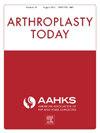Efficacy of Adjunctive Antiseptic Lavage Solution in Managing Acute Hip/Knee Prosthetic Joint Infection: A Comparative Study in a Tertiary Revision Center
IF 1.5
Q3 ORTHOPEDICS
引用次数: 0
Abstract
Background
Debridement, antibiotics and implant retention (DAIR) procedure is well-established as a management option for acute periprosthetic joint infection (PJI). We investigated the infection eradication rates of DAIR procedures at our center using Bactisure wound lavage.
Methods
A retrospective consecutive review of DAIR procedures for hip and knee PJI was conducted between 2018 and 2023 with a minimum 12-month follow-up at our tertiary revision arthroplasty center. Suitability for DAIR was determined at the multi-disciplinary team discussion. Revision procedures and patients with previous PJI were excluded. Patient, surgical, microbiological, and postoperative data (minimum 12 months) was reviewed. The use of Bactisure was in addition to routine surgical management.
Results
During the study period, 76 DAIR procedures were performed (55 knees and 21 hips). Bactisure was used in 26 cases (20 knees and 6 hips). Overall, 6 of 26 Bactisure DAIRs failed (23%), while 14 of 50 non-Bactisure DAIRs failed (28%), which did not demonstrate statistical significance (P = .644). Subgroup analysis demonstrated no difference in knee DAIRs (P = .761) but a trend toward significance in hip DAIRs (P = .262). No adverse effects of Bactisure use were noted intraoperatively or postoperatively. DAIR failed in 50% of diabetic patients compared to 20% of nondiabetic patients (P = .015). Age, body mass index, and organism identification did not influence outcome.
Conclusions
The addition of Bactisure to DAIR procedures did not demonstrate statistically significant improvement of successful eradication of infection, but a potential trend toward significance was noted in hip DAIRs. Diabetic patients failed DAIR in 50% of cases. The in-vivo outcomes of Bactisure use during DAIR procedures remain inconclusive.
求助全文
约1分钟内获得全文
求助全文
来源期刊

Arthroplasty Today
Medicine-Surgery
CiteScore
2.90
自引率
0.00%
发文量
258
审稿时长
40 weeks
期刊介绍:
Arthroplasty Today is a companion journal to the Journal of Arthroplasty. The journal Arthroplasty Today brings together the clinical and scientific foundations for joint replacement of the hip and knee in an open-access, online format. Arthroplasty Today solicits manuscripts of the highest quality from all areas of scientific endeavor that relate to joint replacement or the treatment of its complications, including those dealing with patient outcomes, economic and policy issues, prosthetic design, biomechanics, biomaterials, and biologic response to arthroplasty. The journal focuses on case reports. It is the purpose of Arthroplasty Today to present material to practicing orthopaedic surgeons that will keep them abreast of developments in the field, prove useful in the care of patients, and aid in understanding the scientific foundation of this subspecialty area of joint replacement. The international members of the Editorial Board provide a worldwide perspective for the journal''s area of interest. Their participation ensures that each issue of Arthroplasty Today provides the reader with timely, peer-reviewed articles of the highest quality.
 求助内容:
求助内容: 应助结果提醒方式:
应助结果提醒方式:


